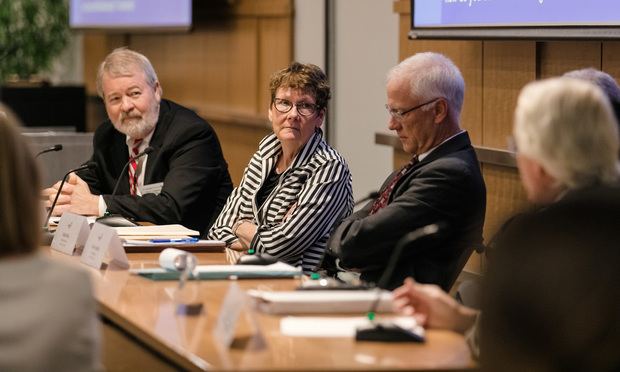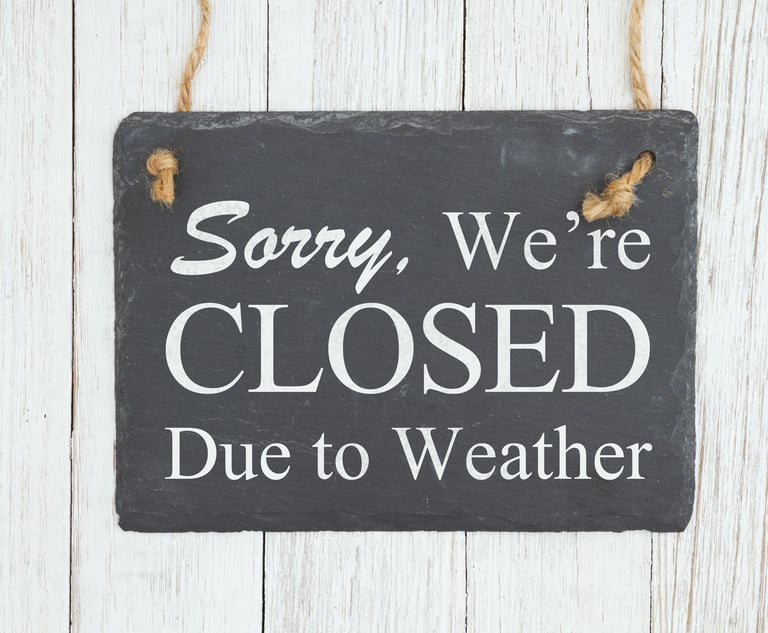‘We Were The Catalyst’: How Atlanta Legal Aid Launched a Landmark SCOTUS Ruling
The U.S. Supreme Court's Olmstead opinion, which held that the “unjustified isolation” of people with disabilities in institutions is a form of discrimination, turns 20 years old this year.
August 13, 2019 at 03:17 PM
6 minute read
 Paul A. Lombardo, Georgia State University law professor (from left), Sylvia Caley, former Atlanta Legal Aid attorney, GSU law professor emerita, and Charles Bliss, Atlanta Legal Aid Society director of advocacy. (Courtesy photo)
Paul A. Lombardo, Georgia State University law professor (from left), Sylvia Caley, former Atlanta Legal Aid attorney, GSU law professor emerita, and Charles Bliss, Atlanta Legal Aid Society director of advocacy. (Courtesy photo)
When the Atlanta Legal Aid Society began representing two women with mental disabilities 20 years ago, none of the lawyers expected to be on the crest of a new civil rights movement.
When Legal Aid lawyer Sue Jamieson first began representing the woman who would become the lead plaintiff in Olmstead v. L.C and E.W., Lois Curtis was housed at a state psychiatric hospital in Atlanta. She was developmentally disabled and diagnosed with schizophrenia, but the medical professionals treating her had determined that, while she needed community residential services, involuntary hospitalization was no longer warranted.
Jamieson set out to secure Curtis’ release from Georgia Regional Hospital and compel the state to provide residential living in a community setting with the support Curtis needed.
Four years later, the U.S. Supreme Court affirmed the findings of a federal trial judge in Atlanta and the U.S. Court of Appeals for the Eleventh Circuit, holding that the “unjustified isolation” of people with disabilities in institutions is a form of discrimination.
Justice Ruth Bader Ginsberg penned the 1999 opinion that rested on the Americans With Disabilities Act of 1990.
Since then, the case has become the disability community’s Brown v. Board of Education, said Samuel Bagenstos, a University of Michigan law professor and a former principal deputy attorney general for civil rights at the U.S. Justice Department. Bagenstos gave the keynote address on Aug. 8 at a conference hosted by Georgia State University to recognize Olmstead’s 20th anniversary.
Rather than locking disabled individuals away from society, Olmstead promoted their interaction, wherever possible, with society.
Atlanta Legal Aid’s executive director, Steven Gottlieb, said Jamieson wasn’t just trying to get people out of state institutions when she sued Tommy Olmstead, the commissioner of Georgia’s Department of Human Resources, on Curtis’s behalf.
“She was trying to figure out a way to get services on the outside so they wouldn’t just get let out of institutions and put into homeless shelters,” Gottlieb said. “That is always what Sue has done—keep us grounded about what the mission is. To keep people in the community, not just out to be on the streets.”
Former Atlanta Legal Aid lawyer Sylvia Caley, who teamed up with Jamieson, said they never intended for the case to be a class action.
“The facts were too different. The patients’ needs were too different,” she said. “And we were aware the courts didn’t like class actions in these cases.”
Caley eventually became the point person for a second plaintiff, Elaine Wilson, who was also in a state hospital for a personality disorder. “My job was to create proof that she could be served effectively in the community with the appropriate supports,” Caley said.
Caley accompanied Wilson to every medical appointment for three years. “One of my main jobs at the end of every doctor’s visit was to ensure the attending wrote in the progress notes that Elaine was capable of living in the community with appropriate supports,” she said.
“It was very important for these two women to know us,” Caley added. “We weren’t just more strangers they had to deal with in their institutionalized life.”
Charles Bliss, Legal Aid’s director of advocacy, said he signed on after the case was filed. While Jamieson focused on constitutional due process issues, Bliss focused on language in the Americans With Disabilities Act that he contended entitled Curtis and Wilson to appropriate support in a community setting.
In depositions with medical professionals, Bliss said, “I would wrap them up with the doctor saying, ‘Yes, this person could be treated in the community with adequate support.’ That sealed the ADA deal.”
Bliss also said that Legal Aid lawyers effectively challenged the state’s contention that institutionalization was cheaper than community placement and individualized services. “The state’s argument … was the sky is falling. This is too expensive to accomplish,” he said. “We presented material facts that it was going to be much cheaper to treat [Curtis and Wilson] in the community.”
“That was essential to the case,” Bliss said.
Judge Marvin Shoob of the U.S. District Court for the Northern District of Georgia incorporated that finding in a 1997 order granting summary judgment to Curtis and Wilson.
The state appealed to the Eleventh Circuit, which affirmed Shoob in a case of first impression in 1998. The Eleventh Circuit held that the ADA bars the state from institutionalizing a disabled individual if that person can receive appropriate treatment in an integrated community setting.
When the state asked the U.S. Supreme Court to hear the case, Legal Aid turned to Atlanta attorney Teresa Wynn Roseborough for help. Roseborough, now general counsel and executive vice president at Home Depot, was then a partner at Sutherland, Asbill & Brennan, now Eversheds Sutherland.
With favorable rulings in hand from the federal trial and appellate courts, Roseborough said her job was to persuade the high court not to take it.
The Eleventh Circuit ruling “was a home run decision out of a court not known to give home run decisions to this type of case,” she said. “Having already had a cupcake with icing on it, my job was to defend that. And I failed.”
Roseborough said Legal Aid decided to argue that the appellate ruling was “run of the mill, business as usual.”
“That approach was not without controversy,” she said. Some argued the case could be won at the Supreme Court and that they should make “the most full-throated defense we could” that institutional segregation was a form of discrimination and “not devalue that holding in trying to get the Supreme Court not to take the case.”
But, she said, “We thought having the Eleventh Circuit decision developed through the other courts of appeals was actually the best way to give the holding the best foundation it needed ultimately to be sustained by the Supreme Court when it eventually got there.”
Gottlieb said it was after the Eleventh Circuit ruling that legal aid lawyers began to realize “that we were part of a movement—the same way that Brown was part of a movement—that was bigger than us.”
“We were the catalyst and we were the focal point for it. … But I did not know that to begin with.”
This content has been archived. It is available through our partners, LexisNexis® and Bloomberg Law.
To view this content, please continue to their sites.
Not a Lexis Subscriber?
Subscribe Now
Not a Bloomberg Law Subscriber?
Subscribe Now
NOT FOR REPRINT
© 2025 ALM Global, LLC, All Rights Reserved. Request academic re-use from www.copyright.com. All other uses, submit a request to [email protected]. For more information visit Asset & Logo Licensing.
You Might Like
View All
Georgia's Governor Details Spending Plans but Not His Top Priority of Lawsuit Reform
6 minute read
Fourth Circuit Seeks More Legal Briefs in Unresolved N.C. Supreme Court Election
4 minute read
Fulton DA Seeks to Overturn Her Disqualification From Trump Georgia Election Case
3 minute readTrending Stories
- 1The Legal Status of Presidential Diaries Must Be Clarified
- 2Litigators of the Week: Shortly After Name Partner Kathleen Sullivan’s Retirement, Quinn Emanuel Scores Appellate Win for Vimeo
- 3Litigator of the Week Runners-Up and Shout-Outs
- 4Weil Hires White & Case Partner in Rebuild of London Finance Ranks
- 5Morgan Lewis Closes Shenzhen Office After Less Than Two Years
Who Got The Work
J. Brugh Lower of Gibbons has entered an appearance for industrial equipment supplier Devco Corporation in a pending trademark infringement lawsuit. The suit, accusing the defendant of selling knock-off Graco products, was filed Dec. 18 in New Jersey District Court by Rivkin Radler on behalf of Graco Inc. and Graco Minnesota. The case, assigned to U.S. District Judge Zahid N. Quraishi, is 3:24-cv-11294, Graco Inc. et al v. Devco Corporation.
Who Got The Work
Rebecca Maller-Stein and Kent A. Yalowitz of Arnold & Porter Kaye Scholer have entered their appearances for Hanaco Venture Capital and its executives, Lior Prosor and David Frankel, in a pending securities lawsuit. The action, filed on Dec. 24 in New York Southern District Court by Zell, Aron & Co. on behalf of Goldeneye Advisors, accuses the defendants of negligently and fraudulently managing the plaintiff's $1 million investment. The case, assigned to U.S. District Judge Vernon S. Broderick, is 1:24-cv-09918, Goldeneye Advisors, LLC v. Hanaco Venture Capital, Ltd. et al.
Who Got The Work
Attorneys from A&O Shearman has stepped in as defense counsel for Toronto-Dominion Bank and other defendants in a pending securities class action. The suit, filed Dec. 11 in New York Southern District Court by Bleichmar Fonti & Auld, accuses the defendants of concealing the bank's 'pervasive' deficiencies in regards to its compliance with the Bank Secrecy Act and the quality of its anti-money laundering controls. The case, assigned to U.S. District Judge Arun Subramanian, is 1:24-cv-09445, Gonzalez v. The Toronto-Dominion Bank et al.
Who Got The Work
Crown Castle International, a Pennsylvania company providing shared communications infrastructure, has turned to Luke D. Wolf of Gordon Rees Scully Mansukhani to fend off a pending breach-of-contract lawsuit. The court action, filed Nov. 25 in Michigan Eastern District Court by Hooper Hathaway PC on behalf of The Town Residences LLC, accuses Crown Castle of failing to transfer approximately $30,000 in utility payments from T-Mobile in breach of a roof-top lease and assignment agreement. The case, assigned to U.S. District Judge Susan K. Declercq, is 2:24-cv-13131, The Town Residences LLC v. T-Mobile US, Inc. et al.
Who Got The Work
Wilfred P. Coronato and Daniel M. Schwartz of McCarter & English have stepped in as defense counsel to Electrolux Home Products Inc. in a pending product liability lawsuit. The court action, filed Nov. 26 in New York Eastern District Court by Poulos Lopiccolo PC and Nagel Rice LLP on behalf of David Stern, alleges that the defendant's refrigerators’ drawers and shelving repeatedly break and fall apart within months after purchase. The case, assigned to U.S. District Judge Joan M. Azrack, is 2:24-cv-08204, Stern v. Electrolux Home Products, Inc.
Featured Firms
Law Offices of Gary Martin Hays & Associates, P.C.
(470) 294-1674
Law Offices of Mark E. Salomone
(857) 444-6468
Smith & Hassler
(713) 739-1250







